|
Traditional
Kaesong and the Koryo
Museum
|
|||||||
|
Kaesong, located just a short trip from the DMZ, was once the capital of the whole country, back during the Koryo dynasty. At the time it was famous for its artistic development, Buddhism, and the beauty of its women. Though not many traditional areas remain the North has preserved and restored a small area of buildings that now mainly serve as restaurants. The sudden trip back into a quieter, more traditional Korea after the modern mess of the DMZ makes for a radical change of atmosphere. The buildings shown below are only 15-20 minutes from the DMZ but seem a world away. The lunch was all done in a very traditional style with everyone sitting on the floor while dishes served by women in traditional hanbok gradually filled up the tables in front of us. The only thing that seemed out of place (other than us) was the meat. Having dined on dog meat numerous times in the South most of us agreed that we probably weren't eating beef . . . Squeamish diners beware - nothing says you're eating dog like having little hairs poking out of the fatty parts of the meat! |
|||||||
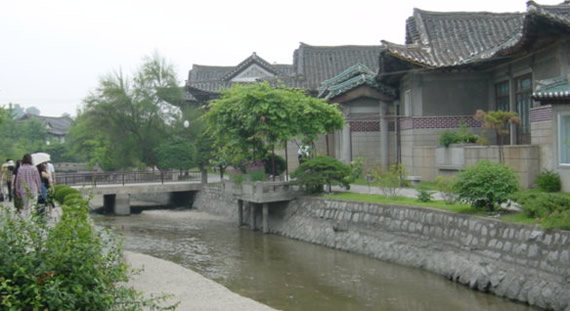 Walking through a small, traditional part of Kaesong to our restaurant. Photo courtesy Dan Harmon |
|||||||
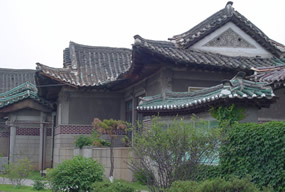 Kaesong traditional rooflines Photo courtesy Thomas St. John |
Sitting inside the old, restored house I couldn't believe I was in the North, especially so close to the border. It reminded me of similar historic areas in the South. After the meal, questionable though the meat may have been, and a short walk through the area, it was easy to imagine this place becoming quite popular with South Korean tourists should the border ever reopen. Especially given Kaesong's reputation as a well-heeled place of wine, women and song. |
|
Of course, based on Kaesong's fame as the home of beautiful kisaeng (kind of a Korean geisha) I would also bet that parts of this area could become a well-known red light district, post-reunification. Perhaps a more traditional, upscale version of Seoul's well-known Chongnyangni and Miari red light areas. To the right you can see another of the restaurants in the restored area, this one specializing in noodles. Unfortunately 'The Schedule' prevented us from trying any of the other places, or even enjoying a leisurely walk through the area. After a quick stop at a souvenir shop it was back on the bus and off to the Koryo Museum. |
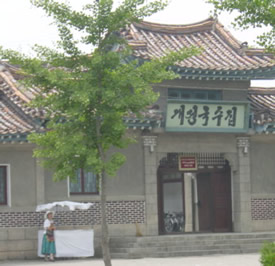 Noodle Restaurant, Kaesong Photo courtesy Dan Harmon |
|
- The sign carries a message quite common on buildings and roadways in the North. Roughly translated it says 'Whatever the Great Comrade Kim Jong-il Decides, We Do!'. |
|
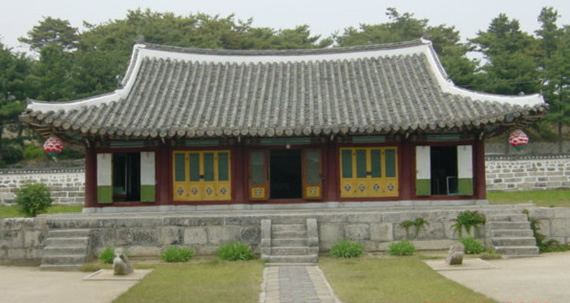 Rear building of the Koryo Museum Photo courtesy Dan Harmon |
|
|
The museum was only a short ride away from Kaesong and set in a peaceful, natural setting. The place was empty of other tourists and, other than the pleasant grounds, really didn't have that much to see. Wandering the grounds was nice but this was one of the few places where 'The Schedule' about matched how long everyone wanted to spend in the place. |
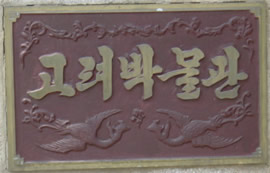 Plaque identifying the 'Koryo Museum' Photo courtesy Dan Harmon |
|
Even in an empty place surrounded by high walls we still had to have not only the on-site guide but all of our guides looking over us as well. The picture to the right, purporting to show the prices of various slaves in the Chosun dynasty, addresses one of the hotter topics in Korean Studies right now. |
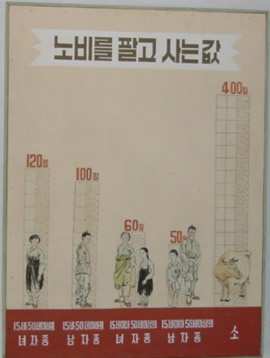 Museum plaque showing prices of slaves during Korea's Chosun dynasty. Photo courtesy Dan Harmon |
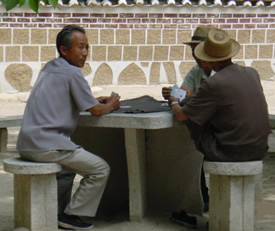 Old men playing cards Photo courtesy Dan Harmon |
Old men are probably pretty much the same everywhere. Without much to do and probably bored hanging out at home these gentlemen decided to spend part of their summer day sitting in the shade and playing cards. Would hazard a guess that in Kimland they're not doing any gambling though . . . Behind the three guys you can see part of the well-restored wall that goes most of the way around the museum complex. Hard to believe such a peaceful place is so close to the border but just like in the South people seem to have grown used to living near a possible warzone. |
|
Also just like in the South, couples about to be married head to a traditional place with a photographer and a couple of friends to take a round of wedding photos. Most likely the couple here hasn't gotten married yet - they're just getting some pictures for the album before the big day. The idea that the groom shouldn't see the bride in her wedding dress ahead of time has never really caught on in Korea. We had a chance to speak briefly with the groom, who spoke surprisingly good English. Somewhere in their wedding album they have a picture of all of us as well. |
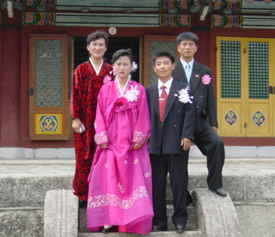 Wedding Party Photo courtesy Dan Harmon |
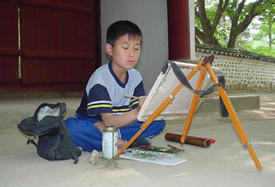 Young Painter Photo courtesy Thomas St. John |
The young man shown here was out painting with his father on the grounds of the museum. A site familiar to anyone who has visited the palaces in South Korea. The father was actually a professional - his works were for sale. Judging from his son's paintings, he would soon be following in his old man's footsteps. One of the things that struck me most about the trip to the museum was how much it reminded me of similar places in the South. Not just the building design, that's a given considering how close the place is to Seoul, but the people. |
| The most striking similarities are shown in these last three pictures - people using the palace/museum in exactly the same ways they're used in the South. We were the only tourists there, everyone else was just using the place as a park or backdrop. Again, scenes familiar to anyone who's spent time traveling in the South. This museum was the only place in all of North Korea where I felt I saw strong similarities between the two countries. The rest of the time it felt more like I was on opposite ends of the planet, rather than the 38th parallel. | ||||
| 6. DMZ | ||||
| Download Journey into Kimland as a single pdf (opens in new window). | ||||
|
Index
|
||
| 4. Yanggakdo Hotel | ||
| 5. Arirang Festival | 6. DMZ | |
| 7. Traditional Kaesong | 8. Pyongyang Circus | |
| 9. Mt. Myohyang | 10. Kim's Birthplace | |
| 11. Departure | ||
|
-
go to 1stopKorea homepage
|
|||||||
|
Copyright 1999-2003 1stopKorea
|
|||||||